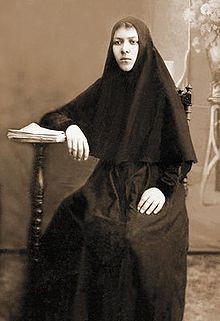Apostolnik
- Apostolnik
-

Religieuse russe portant l'
apostolnik ;
il s'
agit d'
une martyre de l'
orthodoxie,
sœur Catherine Constantinova (
1887-
1938)
Un apostolnik (en russe: апостольник) ou épimandylion (en grec) est le vêtement que portent les religieuses de l'Église orientale. C'est un voile qui couvre la tête, le cou, les épaules, et tout le haut du corps, et ne laisse paraître que le visage. Il est de couleur noire et très rarement de couleur blanche[1]. Ce voile est porté dès le noviciat.
La religieuse peut porter au-dessus la skouphia (ou skouphos en grec), petit bonnet de tissu noir à bout rond, ou bien le kamilavkion en forme de cylindre, ou encore le klobouk, typique de la tradition russe, en fonction de son degré d'importance dans la hiérarchie. L'apostolnik n'est porté ni par les novices grecques, qui portent un grand fichu noir, ni par les religieuses roumaines, dont le voile est différent.
L'origine de ce vêtement vient de l'Empire byzantin. Ainsi Théodoret de Cyr, au Ve siècle, décrit Domnina de Syrie:« elle était couverte d'un long voile qui lui descendait jusqu'aux genoux. » Ce voile descend généralement jusqu'à la taille.
Notes
Wikimedia Foundation.
2010.
Contenu soumis à la licence CC-BY-SA. Source : Article Apostolnik de Wikipédia en français (auteurs)
Regardez d'autres dictionnaires:
Apostolnik — An apostolnik or epimandylion is an item of clerical clothing worn by Orthodox Christian and Eastern Catholic nuns. A cloth veil which completely covers the head (except for the face), neck, and shoulders [http://www.sestry.ru/church/img/1053]… … Wikipedia
Monastery — of St. Nilus on Stolbnyi Island in Lake Seliger near Ostashkov, Russia, ca. 1910 … Wikipedia
Nun — For other uses, see Nun (disambiguation). Nun in cloister, 1930; photography by Doris Ulmann A nun is a woman who has taken vows committing her to live a spiritual life.[1] She may be an ascetic who volunta … Wikipedia
Veil — This article is about the article of clothing, or a religious item. For other uses, see Veil (disambiguation). Standing woman holding her veil. Terracotta figurine, ca. 400–375 BC. A veil is an article of clothing, worn almost exclusively by… … Wikipedia
Novice — For other uses, see Novice (disambiguation). A novice is a person or creature who is new to a field or activity. The term is most commonly applied in religion and sports. Contents 1 Religion 1.1 Buddhism 1.2 Christianity … Wikipedia
Christian monasticism — Icon of Saint Anthony the Great, the founder of Christian monasticism. Christian monasticism is a practice which began to develop early in the history of the Christian Church, modeled upon scriptural examples and ideals, including those in the… … Wikipedia
Clerical clothing — is non liturgical clothing worn exclusively by clergy. It is distinct from vestments in that it is not reserved specifically for services. Practices vary: clerical clothing is sometimes worn under vestments, and sometimes as the everyday clothing … Wikipedia
Epanokamelavkion — An epanokamelavkion (also epanokameloukion or epanokalimafko) is an item of clerical clothing worn by Orthodox Christian monastics who are rassophor or above, including bishops. It is a cloth veil, usually black, which is worn with a kamilavkion … Wikipedia
Religious habit — St. Anthony the Great, wearing the Coptic habit. A religious habit is a distinctive set of garments worn by members of a religious order. Traditionally some plain garb recognisable as a religious habit has also been worn by those leading the… … Wikipedia
Christian headcovering — The Christian headcovering is a veiling worn by various Christian women from a variety of traditions. Some cover only in church or while praying; most never cover their heads all the time. They refer to 1 Corinthians 11, or to custom, as the… … Wikipedia

